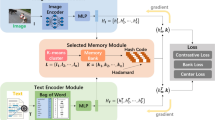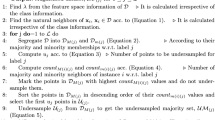Abstract
Multi-view learning with incomplete views (MVL-IV) is a reliable algorithm to process incomplete datasets which consist of instances with missing views or features. In MVL-IV, it exploits the connections among multiple views and suggests that different views are generated from a shared subspace such that it can recover the missing views or features well while MVL-IV neglects two facts. One is that different views should always be generated from different subspaces. The other is that the information of view-based classifiers is useful to the design of MVL-IV. Thus, on the base of MVL-IV, we consider these two facts and develop a new multi-view learning with incomplete data (NMVL-IV). Related experiments on clustering, regression, classification, bipartite ranking, and image retrieval have validated that the proposed NMVL-IV can recover the incomplete data much better.





















Similar content being viewed by others
Notes
In MVL-IV, incomplete-view case includes missing views, missing features, and missing data
Since the new machine is developed on the base of MVL-IV which can recover incomplete data, for consistency, the new machine is also abbreviated as NMVL-IV rather than NMVL-ID.
SR-LS: self-representation-based matrix completion by least-square, SR-LR: self-representation-based matrix completion by low-rank, SR-Sp: self-representation-based matrix completion by sparse self-representations
Downloaded from ‘http://archive.ics.uci.edu/ml/datasets/Multiple+Features.’
Downloaded from ‘http://archive.ics.uci.edu/ml/datasets/Corel+Image+Features.’
References
Xu YM, Wang CD, Lai JH (2016) Weighted multi-view clustering with feature selection. Pattern Recognit 53:25–35
Tzortzis G, Likas A (2012) Kernel-based weighted multi-view clustering. In: 2012 IEEE 12th international conference on data mining, pp 675–684
Sun SL, Zhang QJ (2011) Multiple-view multiple-learner semi-supervised learning. Neural Process Lett 34:229–240
Deng MQ, Wang C, Chen QF (2016) Human gait recognition based on deterministic learning through multiple views fusion. Pattern Recognit Lett 78(C):56–63
Wu F, Jing XY, You XG, Yue D, Hu RM, Yang JY (2016) Multi-view low-rank dictionary learning for image classification. Pattern Recognit 50:143–154
Zhu SH, Sun X, jin DL (2016) Multi-view semi-supervised learning for image classification. Neurocomputing 208:136–142
Wang HY, Wang X, Zheng J, Deller JR, Peng HY, Zhu LQ, Chen WG, Li XL, Liu RJ, Bao HJ (2014) Video object matching across multiple non-overlapping camera views based on multi-feature fusion and incremental learning. Pattern Recognit 47(12):3841–3851
Xu C, Tao DC, Xu C (2015) Multi-view learning with incomplete views. IEEE Trans Image Process 24(12):5812–5825
Candès EJ, Recht B (2009) Exact matrix completion via convex optimization. Found Comput Math 9(6):717–772
Rennie JDM, Srebro N (2005) Fast maximum margin matrix factorization for collaborative prediction. In: International conference DBLP, pp 713–719
Keshavan RH, Montanari A, Oh S (2010) Matrix completion from a few entries. IEEE Trans Inf Theory 56(6):2980–2998
Gong P, Ye, J Zhang CS (2012) Multi-stage multi-task feature learning. In: International conference on neural information processing systems, pp. 1988–1996
Evgeniou A, Pontil M (2007) Multi-task feature learning. In: International conference on neural information processing systems, vol 73, no 3, pp 41–48
Wang X, Bi J, Yu S, Sun J (2014) On multiplicative multitask feature learning. In: International conference on neural information processing systems, pp 2411–2419
Gyamfi KS, Brusey J, Hunt A, Gaura E (2017) Linear classifier design under heteroscedasticity in Linear Discriminant Analysis. Expert Syst Appl 79:44–52
Lee C, Woo S (2019) Linear classifier design in the weight space. Pattern Recognit 88:210–222
Örnek C, Vural E (2019) Nonlinear supervised dimensionality reduction via smooth regular embeddings. Pattern Recognit 77:55–66
Padierna LC, Carpio M, Domínguez AR, Puga H, Fraire H (2018) A novel formulation of orthogonal polynomial kernel functions for SVM classifiers: the Gegenbauer family. Pattern Recognit 84:211–225
Lin F, Chen J (2018) Learning low-complexity autoregressive models via proximal alternating minimization. Syst Control Lett 122:48–53
Xie JX, Liao AP, Lei Y (2018) A new accelerated alternating minimization method for analysis sparse recovery. Sig Process 145:167–174
Hardoon D, Szedmak S, Shawe-Taylor J (2004) Canonical correlation analysis: an overview with application to learning methods. Neural Comput 16(12):2639–2664
Sun TK, Chen SC (2007) Locality preserving CCA with applications to data visualization and pose estimation. Image Vis Comput 25(5):531–543
Peng Y, Zhang DQ, Zhang JC (2010) A new canonical correlation analysis algorithm with local discriminant. Neural Process Lett 31(1):1–15
Zu C, Zhang DQ (2016) Canonical sparse cross-view correlation analysis. Neurocomputing 191:263–272
Zhu CM, Wang Z, Gao DQ (2015) Globalized and localized canonical correlation analysis with multiple empirical kernel mapping. Neurocomputing 154:257–275
Wang GX, Zhang CQ, Zhu PF, Hu QH (2017) Semi-supervised multi-view multi-label classification based on nonnegative matrix factorization. In: International conference on artificial neural networks and machine learning, pp 340–348
Qian BY, Wang X, Ye JP, Davidson I (2015) A reconstruction error based framework for multi-label and multi-view learning. IEEE Trans Knowl Data Eng 27(3):594–607
Chawla NV, Bowyer KW, Hall LO (2002) SMOTE: synthetic minority over-sampling technique. J Artif Intell Res 16(1):321–357
Zeng FX, Zhang WS, Zhang SH, Zheng N (2019) Re-KISSME: a robust resampling scheme for distance metric learning in the presence of label noise. Neurocomputing 330:138–150
Ren SQ, Zhu W, Liao B, Li Z, Wang P, Li KQ, Chen M, Li ZJ (2019) Selection-based resampling ensemble algorithm for nonstationary imbalanced stream data learning. Knowl-Based Syst 163:705–722
Shon A, Grochow K, Hertzmann A, Rao RP (2005) Learning shared latent structure for image synthesis and robotic imitation. In: Conference on neural information processing systems, pp 1233–1240
Fan JC, Chow TWS (2017) Matrix completion by least-square, low-rank, and sparse self-representations. Pattern Recognit 71:290–305
Fan JC, Chow TWS (2018) Non-linear matrix completion. Pattern Recognit 77:378–394
Goldberg AB, Zhu XJ, Recht B, Xu JM, Nowak R (2010) Transduction with matrix completion: three birds with one stone. Adv Neural Inf Process Syst 23:757–765
Zhu CM, Zhou RG, Zu C (2019) Weight-based canonical sparse cross-view correlation analysis. Pattern Anal Appl 22(2):457–476
White M, Zhang X, Schuurmans D, Yu YL (2012) Convex multi-view subspace learning. In: International conference on neural information processing systems, pp 1673–1681
Jia Y, Salzmann M, Darrell T (2010) Factorized latent spaces with structured sparsity. In: Conference on neural information processing systems, pp 982–990
Asuncion A, Newman D (2007) UCI machine learning repository. http://archive.ics.uci.edu/ml/
Amini MR, Usunier N, Goutte C (2009) Learning from multiple partially observed views-an application to multilingual text categorization. In: Neural information processing systems (NIPS), pp 28–36
http://multilingreuters.iit.nrc.ca/ReutersMultiLingualMultiView.htm
Zhu CM, Wang Z (2017) Entropy-based matrix learning machine for imbalanced data sets. Pattern Recognit Lett 88:72–80
Zhao P, Jiang Y, Zhou ZH (2017) Multi-view matrix completion for clustering with side information. In: Proceedings of the 21st Pacific-Asia conference on knowledge discovery and data mining, pp 403–415
The FG-NET Aging Database. http://sting.cycollege.ac.cy/?alanitis/fgnetaging/index.htm
Drucker H, Burges CJC, Kaufman L, Smola AJ, Vapnik V (1997) Support vector regression machines. In: Advances in neural information processing systems, pp 155–161
Johansson U, Linusson H, Löfström T, Boström H (2018) Interpretable regression trees using conformal prediction. Expert Syst Appl 97:394–404
Chang KY, Chen CS, Hung YP (2011) Ordinal hyperplanes ranker with cost sensitivities for age estimation. In: IEEE conference on computer vision and pattern recognition, pp 585–592
Cortes C, Vapnik V (1995) Support-vector networks. Mach Learn 20(3):273–297
Usunier N, Amini MR, Goutte C (2011) Multiview semi-supervised learning for ranking multilingual documents. In: Lecture notes in computer science, pp 443–458
Cao HL, Bernard S, Sabourin R, Heuttea L (2019) Random forest dissimilarity based multi-view learning for Radiomics application. Pattern Recognit 88:185–197
Kusakunniran W, Wu Q, Zhang J, Li HD (2012) Cross-view and multi-view gait recognitions based on view transformation model using multi-layer perceptron. Pattern Recognit Lett 33(7):882–889
Jorge J, Paredes R (2018) Passive-aggressive online learning with nonlinear embeddings. Pattern Recognit 79:162–171
Wang XQ, Wei D, Cheng H, Fang JL (2016) Multi-instance learning based on representative instance and feature mapping. Neurocomputing 216:790–796
You XH, Ma SR, Yan SJ (2009) The explicit solution to equation AX + XB = C in matrices. Chin Q J Math 24(4):516–524
Acknowledgements
This work is supported by National Natural Science Foundation of China (CN) under Grant Number 61602296, Natural Science Foundation of Shanghai under Grant Number 16ZR1414500, Project funded by China Postdoctoral Science Foundation under Grant Number 2019M651576. Furthermore, this work is also sponsored by ‘Chenguang Program’ supported by Shanghai Education Development Foundation and Shanghai Municipal Education Commission under Grant Number 18CG54. The authors would like to thank their supports.
Author information
Authors and Affiliations
Corresponding author
Additional information
Publisher's Note
Springer Nature remains neutral with regard to jurisdictional claims in published maps and institutional affiliations.
Rights and permissions
About this article
Cite this article
Zhu, C., Chen, C., Zhou, R. et al. A new multi-view learning machine with incomplete data. Pattern Anal Applic 23, 1085–1116 (2020). https://doi.org/10.1007/s10044-020-00863-y
Received:
Accepted:
Published:
Issue Date:
DOI: https://doi.org/10.1007/s10044-020-00863-y




